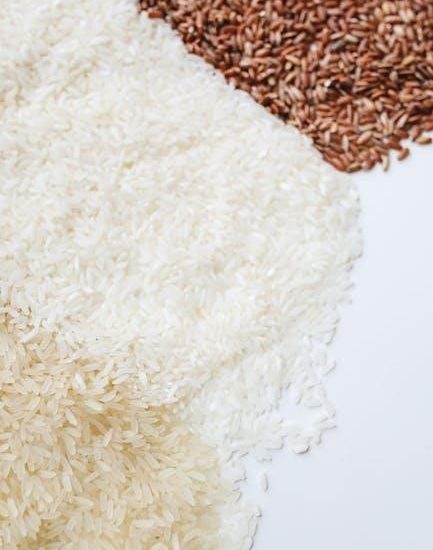A low sulfur diet is a nutritional approach aimed at reducing digestive discomfort by limiting sulfur-rich foods, often beneficial for managing conditions like SIBO and sulfur intolerance.
Overview of the Low Sulfur Diet
A low sulfur diet is a short-term elimination plan designed to reduce symptoms like bloating, gas, and digestive discomfort. It focuses on minimizing foods high in sulfur compounds, such as certain proteins, cruciferous vegetables, and processed foods. This approach is particularly beneficial for individuals with conditions like SIBO or sulfur intolerance. While sulfur is essential for health, excessive amounts can exacerbate symptoms in sensitive individuals, making this diet a practical solution for managing specific digestive issues.
Importance of Understanding Sulfur in the Diet
Understanding sulfur’s role in the diet is crucial for managing digestive health. While sulfur is vital for bodily functions, excessive intake can disrupt gut balance, especially in those with SIBO or intolerance. Recognizing sulfur-rich foods and their effects helps individuals make informed choices, reducing symptoms like bloating and gas. This knowledge empowers those adopting a low sulfur diet to tailor their nutrition effectively, balancing health needs with dietary constraints for better overall well-being and symptom management.
What is a Low Sulfur Diet?
A low sulfur diet is a nutritional approach that minimizes sulfur intake to alleviate digestive issues, particularly for those with SIBO or sulfur sensitivity.
Definition and Purpose
A low sulfur diet is a dietary approach designed to minimize sulfur intake, targeting individuals with conditions like SIBO or sulfur sensitivity. By reducing sulfur-rich foods, it aims to alleviate digestive symptoms such as bloating, gas, and diarrhea. This short-term elimination diet helps identify trigger foods and allows the gut to heal. Its purpose is to create a personalized plan that reduces discomfort while ensuring nutritional balance, tailored to individual tolerance levels and health needs.
Key Principles of the Diet
The low sulfur diet focuses on identifying and avoiding foods high in sulfur compounds. It emphasizes monitoring digestive symptoms and adjusting intake based on tolerance. The diet typically includes an elimination phase, followed by gradual reintroduction of sulfur-containing foods to identify triggers. The goal is to balance nutrition while minimizing discomfort, often under medical supervision to ensure safety and effectiveness for individuals with specific health conditions like SIBO or sulfur sensitivity.

Benefits of a Low Sulfur Diet
Adopting a low sulfur diet can alleviate digestive discomfort, reduce bloating, and enhance energy levels. It supports managing conditions like SIBO and sulfur intolerance, improving overall well-being.
Reduction of Digestive Symptoms
A low sulfur diet can significantly reduce digestive symptoms such as bloating, gas, and diarrhea, particularly in individuals with conditions like SIBO or sulfur intolerance. By minimizing sulfur-rich foods, the diet helps reduce the production of hydrogen sulfide gas in the gut, which often exacerbates discomfort. This approach can lead to a noticeable improvement in digestive health, making it easier to manage chronic bloating and promote a balanced gut microbiome. It is often recommended as a short-term solution to alleviate severe symptoms.
Improved Energy Levels
A low sulfur diet can lead to improved energy levels by reducing the body’s expenditure of energy on managing digestive discomfort. By minimizing sulfur intake, individuals often experience fewer energy-draining symptoms like bloating and fatigue. This dietary approach can also help stabilize blood sugar levels and enhance nutrient absorption, contributing to sustained vitality throughout the day. Many people report feeling more energetic and mentally clear after adopting a low sulfur diet, particularly if they have underlying sulfur sensitivities or intolerances.
Support for Specific Health Conditions
A low sulfur diet provides significant support for individuals with specific health conditions, particularly those with SIBO (Small Intestinal Bacterial Overgrowth) and sulfur intolerance. By reducing sulfur intake, the diet helps minimize symptoms like bloating, gas, and digestive discomfort, which are often exacerbated by high-sulfur foods. This approach is also beneficial for managing conditions where sulfur metabolism is impaired, offering relief and improving overall well-being. It is particularly recommended for those with chronic digestive issues linked to sulfur sensitivity.

Who Needs a Low Sulfur Diet?
Individuals with SIBO, sulfur intolerance, or those experiencing chronic bloating benefit specifically from a low sulfur diet to alleviate digestive symptoms and improve overall well-being.
Individuals with SIBO (Small Intestinal Bacterial Overgrowth)
Individuals with SIBO often benefit from a low sulfur diet, as sulfur-rich foods can exacerbate symptoms by feeding harmful bacteria in the small intestine. This diet helps reduce bloating, gas, and digestive discomfort associated with SIBO. By limiting sulfur intake, it starves the bacteria, potentially improving gut health and alleviating symptoms. This approach is particularly effective for those with hydrogen sulfide-producing bacteria, offering a targeted way to manage SIBO-related issues effectively.
People with Sulfur Intolerance or Sensitivity
Individuals with sulfur intolerance or sensitivity often experience severe digestive issues, such as bloating, gas, and discomfort, when consuming sulfur-rich foods. A low sulfur diet is essential for managing these symptoms, as it reduces exposure to compounds that can trigger reactions. By eliminating high-sulfur foods, individuals can alleviate digestive distress and improve overall well-being. This dietary approach helps identify and avoid specific triggers, providing relief for those with sulfur sensitivity and supporting long-term symptom management effectively.
Those Experiencing Chronic Bloating and Gas
Chronic bloating and gas can be debilitating, often linked to sulfur intake. Sulfur-rich foods feed harmful bacteria in the gut, exacerbating symptoms. A low sulfur diet helps reduce these digestive issues by minimizing sulfur intake, thereby decreasing bacterial fermentation and gas production. This approach is particularly beneficial for individuals with SIBO, as it starves harmful bacteria of their energy source, leading to significant relief from bloating and gas, and improving overall digestive comfort and quality of life.

Identifying High-Sulfur Foods
High-sulfur foods include garlic, onions, cruciferous vegetables, eggs, and processed foods. These foods can exacerbate symptoms in individuals with sulfur sensitivity or conditions like SIBO.
Common High-Sulfur Foods to Avoid
Common high-sulfur foods include garlic, onions, beans, lentils, cruciferous vegetables like broccoli and cauliflower, and animal proteins such as eggs and red meat. Processed foods containing sulfites, like certain wines and dried fruits, should also be avoided. These foods can trigger digestive symptoms in individuals with sulfur intolerance or conditions like SIBO, making them essential to eliminate during the initial phases of a low-sulfur diet.
Hidden Sources of Sulfur in Foods
Some foods contain hidden sulfur sources, such as processed cheeses, deli meats, and condiments with sulfites. Additionally, certain seasonings, food additives, and fortified products may contain sulfur compounds. Even some natural foods, like seafood or whole grains, can have higher sulfur content. Being aware of these less obvious sources is crucial for effectively managing a low-sulfur diet and avoiding unintended sulfur intake;

Steps to Implement a Low Sulfur Diet
Start with an elimination phase, removing high-sulfur foods, then gradually reintroduce them to identify triggers, ensuring a personalized approach to managing sulfur intake effectively.
Elimination Phase
The elimination phase involves removing all high-sulfur foods for 5-7 days to assess symptom improvement. This step helps identify which foods trigger discomfort. Focus on consuming low-sulfur alternatives like fresh fruits, lean meats, and non-cruciferous vegetables. It’s crucial to strictly avoid foods such as garlic, onions, and cruciferous vegetables during this period. Keeping a symptom journal can help track changes and provide insights into personal triggers. This phase is essential for pinpointing specific intolerances and laying the groundwork for the reintroduction phase.
Reintroduction Phase
The reintroduction phase follows the elimination period, where high-sulfur foods are gradually reintroduced one at a time. This step helps identify individual tolerance levels and pinpoint specific triggers. Start with small portions of one food, monitor symptoms for 24-48 hours, and adjust based on how your body reacts. Keeping a symptom journal is key to tracking reactions and personalizing the diet. This phase ensures a tailored approach to managing sulfur intake effectively for long-term symptom relief.

Low Sulfur Food List
A low sulfur diet focuses on lean meats, fresh fruits, and low-sulfur vegetables, avoiding high-sulfur foods like garlic and cruciferous vegetables to reduce digestive issues effectively.
Foods to Include
Focusing on lean proteins like chicken, turkey, and fish is essential. Fresh fruits such as bananas, berries, and apples are low in sulfur and easily digestible. Incorporate low-sulfur vegetables like cucumbers, zucchini, and carrots. Whole grains like rice, quinoa, and oatmeal are also suitable. Healthy fats from sources like avocados and olive oil can be included in moderation. These foods provide balanced nutrition while adhering to the low sulfur diet guidelines, helping to manage symptoms effectively.
Foods to Avoid
Avoid high-sulfur foods like garlic, onions, and cruciferous vegetables such as broccoli, cauliflower, and Brussels sprouts. Processed meats, dried fruits, and fermented foods like cheese and yogurt should also be limited. Additionally, foods containing sulfites, such as wine and some packaged snacks, can exacerbate symptoms. These foods contribute to sulfur overload, which can worsen digestive issues and bloating in sensitive individuals. Eliminating them helps reduce discomfort and supports overall digestive health.

Managing Symptoms on a Low Sulfur Diet
Monitoring and adjusting the diet helps alleviate digestive discomfort, ensuring symptom relief and overall well-being for individuals following this dietary approach.
Tracking Symptoms and Progress
Tracking symptoms and progress is crucial for managing a low sulfur diet effectively. Keeping a daily journal to record digestive discomfort, energy levels, and overall well-being can help identify patterns and triggers. Monitoring how your body responds to specific foods allows for tailored adjustments to the diet. Regularly documenting changes ensures a clearer understanding of what works best for your health; This proactive approach helps maintain consistency and prevents potential setbacks, fostering long-term success on the diet.
Adjusting the Diet Based on Results
As you track your symptoms, use the insights to refine your low sulfur diet. Identify which foods trigger discomfort and adjust portions or avoid them entirely. If symptoms improve, continue with the current plan. Gradual adjustments ensure a personalized approach. Reintroduce foods cautiously, monitoring reactions. Consistent progress validates the diet’s effectiveness. Tailor your choices to maintain relief and optimize digestive health. Adjustments may require professional guidance for complex cases, ensuring the best outcomes for your specific needs.
Reintroducing Sulfur Foods
Reintroducing sulfur foods requires careful monitoring of symptoms. Start with small portions, gradually increasing tolerance levels. This ensures a safe and personalized approach to diet expansion.
How to Safely Reintroduce Sulfur Foods
Reintroducing sulfur foods should be done gradually to assess tolerance. Start with one food at a time, in small amounts, and monitor for symptoms like bloating or gas. Keep a journal to track reactions. If symptoms arise, pause and consider further elimination. The goal is to identify a safe threshold without triggering discomfort. This method ensures a personalized and sustainable approach to expanding your diet safely.
Monitoring Tolerance Levels
Monitoring tolerance levels is crucial when reintroducing sulfur foods. Track symptoms like bloating, gas, or discomfort in a food diary. Note the portion size and timing of each food. If symptoms occur, pause and reassess. Gradually increase portions only if tolerance is confirmed. This process helps identify individual thresholds and ensures a balanced diet without triggering adverse reactions. Regular monitoring allows for personalized adjustments, promoting long-term digestive health and comfort.
Practical Tips for Maintaining a Low Sulfur Diet
Maintaining a low sulfur diet requires careful meal planning, smart grocery shopping, and strategies for handling social dining challenges. Plan ahead, read labels, and stay organized!
Meal Planning and Grocery Shopping
Effective meal planning and grocery shopping are crucial for maintaining a low sulfur diet. Start by creating a weekly meal plan that includes low-sulfur options, ensuring variety and nutrition. Make a shopping list to avoid impulse purchases of high-sulfur foods. Read food labels carefully to identify hidden sulfur sources. Focus on fresh, whole foods like meats, fish, and low-sulfur vegetables. Batch cooking can save time and ensure compliance. Shop for certified low-sulfur products when available, and substitute high-sulfur ingredients with alternatives. Staying organized and prepared makes adhering to the diet easier and more sustainable.
Handling Social and Dining Challenges
Social and dining challenges are common on a low sulfur diet, but there are strategies to navigate them. Communicate openly with hosts or chefs about dietary needs. Carry low-sulfur snacks to ensure options are available. Educate friends and family about the diet to gain support. Choose restaurants with flexible menus and inform servers of restrictions. Plan ahead for events by offering to bring a dish. Staying prepared and proactive can make social dining enjoyable while adhering to the diet.
Common Challenges and Solutions
Common challenges include identifying hidden sulfur sources and managing cravings. Solutions involve careful planning, using sulfur-free substitutes, and staying educated on high-sulfur foods to avoid.
Dealing with Cravings and Nutrient Deficiencies
Cravings for high-sulfur foods can be challenging, but substituting with sulfur-free alternatives like fresh fruits and gluten-free grains helps. Nutrient deficiencies may arise due to limited food options, particularly in vitamin B12 and omega-3 fatty acids. Supplementation and careful meal planning are essential to maintain nutritional balance. Tracking symptoms and identifying triggers can also help manage cravings effectively. Balancing restriction with nutrition ensures long-term success on a low sulfur diet, promoting overall health without compromising compliance.
Staying Motivated on a Restricted Diet
Staying motivated on a low sulfur diet requires setting clear goals and celebrating small victories. Sharing experiences with supportive communities can foster encouragement. Tracking progress and reminding oneself of the benefits, like improved symptoms, helps maintain commitment. Embracing creativity in meal preparation and focusing on long-term health rewards are key. Kindness to oneself during challenges ensures sustained motivation, keeping the journey positive and purposeful.

Success Stories and Testimonials
Many report relief from bloating and improved energy on a low sulfur diet, while others share challenges. Individual experiences vary, emphasizing the importance of tailored approaches and professional guidance.
Real-Life Experiences with the Low Sulfur Diet
Many individuals have shared anecdotal evidence of symptom relief, such as reduced bloating and improved digestion, after adopting a low sulfur diet. Some report significant improvements in energy levels and overall well-being. However, experiences vary, with some finding the diet challenging due to restrictive food choices. Personal stories highlight the importance of tailoring the diet to individual needs and the role of professional guidance in achieving success.
Inspiration for Those Starting the Diet
Starting a low sulfur diet can feel daunting, but many find it rewarding. Success stories reveal improved digestion, reduced bloating, and enhanced energy. Plan meals carefully, focus on nutrient-rich foods, and celebrate small victories. Tracking progress and staying consistent are key. Remember, it’s a journey toward better health—each step brings you closer to feeling your best. Stay motivated by the positive changes you’ll experience along the way.

Mistakes to Avoid on a Low Sulfur Diet
Common pitfalls include not reading food labels for hidden sulfur, overloading on sulfur-rich foods during reintroduction, and neglecting to track symptoms for better diet adjustment.
Common Pitfalls and How to Avoid Them
Common mistakes include not reading food labels for hidden sulfur and overloading on high-sulfur foods during reintroduction; To avoid these, maintain a food diary, reintroduce foods gradually, and focus on fresh, low-sulfur options. Consulting a healthcare provider ensures personalized advice, aiding in sustained compliance and symptom relief. Being mindful of processed foods and staying consistent are key to long-term success on the diet.
Understanding the Importance of Compliance
Compliance with a low sulfur diet is crucial for effectively managing symptoms and achieving long-term benefits. Even small lapses can trigger digestive issues, making consistency key. Strict adherence ensures the diet’s effectiveness, while partial efforts may lead to incomplete relief. Consulting a healthcare provider for personalized guidance helps maintain discipline and addresses challenges, fostering better overall outcomes and sustained well-being.
A low sulfur diet effectively manages digestive symptoms, improving overall well-being. Consistency is key to success. For those starting, patience and commitment yield long-term benefits and enhanced quality of life.
Final Thoughts on the Low Sulfur Diet
A low sulfur diet offers significant benefits for those with specific digestive conditions. By reducing sulfur intake, individuals can alleviate symptoms like bloating and gas, improving their quality of life. This dietary approach, while requiring careful planning, is a valuable tool for managing health. It’s essential to work with a healthcare provider to tailor the diet to individual needs and ensure long-term success.
Encouragement for Long-Term Success
Adopting a low sulfur diet requires commitment but can lead to lasting improvements in digestive health. Staying motivated involves setting realistic goals, celebrating small victories, and seeking support from healthcare providers or communities. With time, the diet becomes a sustainable lifestyle, offering enhanced well-being and energy. Patience and persistence are key to overcoming challenges and achieving long-term success on this transformative journey.
References and Further Reading
For further reading, consult Dr. Michael’s guide on low sulfur diets, scientific studies on SIBO, and patient testimonials for practical insights and evidence-based advice.
Recommended Resources for More Information
Explore Dr. Michael’s comprehensive guide on low sulfur diets, which includes meal plans and scientific insights. Additionally, refer to studies on SIBO and sulfur intolerance, available in medical journals. Patient testimonials and success stories from online forums provide real-life experiences. For practical advice, consult cookbooks tailored to low sulfur diets and join support groups for shared tips and encouragement. These resources offer a well-rounded understanding of the diet and its benefits.
Scientific Studies Supporting the Diet
Research highlights the link between sulfur intake and digestive symptoms, particularly in SIBO patients. Studies show that reducing sulfur-rich foods can alleviate bloating and gas. Findings from nutritional journals demonstrate sulfur’s role in gut bacteria overgrowth. Clinical trials support the diet’s effectiveness in managing IBS symptoms. These studies provide a scientific foundation for adopting a low sulfur diet, emphasizing its benefits for gut health and symptom relief. Refer to medical journals for detailed insights and evidence-based recommendations.

Final Thoughts
The low sulfur diet effectively reduces digestive discomfort, alleviates bloating, and supports gut health, making it a beneficial choice for managing SIBO conditions and intolerance.
The Future of the Low Sulfur Diet
The low sulfur diet is gaining recognition as a valuable approach for managing gut health and reducing symptoms like bloating and gas. As research evolves, it may become a cornerstone for personalized nutrition, especially for those with SIBO or sulfur intolerance. The diet’s future likely includes expanded adoption, refined food lists, and integration into healthcare plans, offering tailored solutions for improved well-being and digestive comfort.
Encouragement for Ongoing Learning
Embrace the low sulfur diet as a journey of discovery and adaptation. Stay informed through credible resources and healthcare professionals to refine your approach. Continuous learning helps tailor the diet to your unique needs, ensuring long-term success and improved well-being. By staying proactive and open to new insights, you can optimize your health and thrive on this transformative dietary path.





